| Mandu : Mandu is a ruined city in the present-day Mandav area of the Dhar district. It is located in the Malwa region of western Madhya Pradesh, India, at 35 km from the Dhar city. In the 11th century, Mandu was the sub division of the Tarangagadh or Taranga kingdom .This fortress town on a rocky outcrop about 100 km from Indore is celebrated for its fine architecture. | |
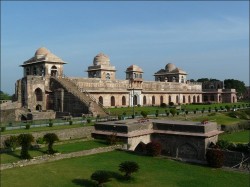 |
#Jahaz Mahal (Ship Palace)
jahaz Mahal, also known as the Ship Palace was built in the 15th century by Ghiyas-ud-din, son of Emperor Mohammed Shah. The two storey palace lies between two artificial lakes, the Munj Talab and the Kapur Talab. This mahal was used by Ghiyas-ud-din as his harem. The palace has open pavilions, an open terrace and balconies. The Taveli Mahal, situated to the south of the Jahaz Mahal, has an antiquity gallery displaying fragments of vessels and utensils, along with some stone images that were found at this site.
|
| #Rupmati’s Pavilion
Rupmati Pavilion, originally built as an army observation post, is a huge sandstone structure situated south of the Baz Bahadur Palace. Rani Rupmati, the queen of Baz Bahadur, used to live at this site. From here, she could see the palace and the Narmada River. It is also an ideal place for watching the sun set over the River Narmada. |
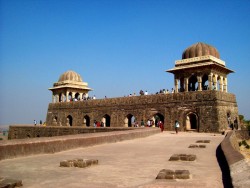 |
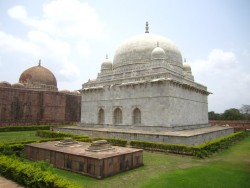 |
#Hoshang’s Tomb
Hoshang’s Tomb is considered to be the first Indian marble monument, constructed in 1440. The tomb is square shaped and is situated near the Jami Masjid, in the Mandu City. It has a dome with towers, courts and marble latticework. The tomb of Hoshang Shah served as a template for Shah Jahan, while constructing the Taj Mahal. |
| #Dilawar Khan Mosque The Mosque of Dilawar Khan, Mandu is, however, an unique example of the fusion of Muslim and Hindu style of architecture. It has a courtyard in the middle and the courtyard is in turn, encompassed by a colonnade. The prayer hall depicts amazingly bold influences of Hindu art forms in the ceilings, columns and gates. Built in 1405, it happens to be the earliest of mosques to have been erected here. The stones used in constructing the mosque, however, were salvaged from the desecrated temples. |
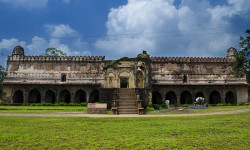 |
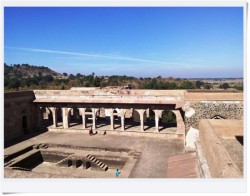 |
#Baz Bahadur’s Palace
Baz Bahadur’s Palace is located near Rewa Kund. In fact, water was supplied from the later to the former. While the Rewa Kund is at top of the hill, this palace is on the slope. Baz Bahadur’s Palace provides exceptional view to the place. There are numerous halls in the courtyard along with rooms on all four sides.
|
| #Hindola Mahal (Swing Palace)
It is also known as Swinging Palace, which has a large meeting hall. Hindola Mahal has become one of the most visited sites in Mandu. According to available evidences, archaeologists say that it was most probably built during the rule of Hoshang Shah between 1425 and end of 15th century. It is considered as one of the palaces in the royal palace complex. Per available records, this was mainly used as an audience chamber. This place has a T-shape with the main hall being 30 meters in length, 18 meters in breadth, and 12 meters in height. It is because of the highly inclined buttresses ,this palace has got such a name. Main hall’s big flat roof was supported by 5 large ogee arches. Best part of this architecture is well proportioned boldness and simplicity.
|
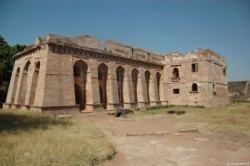 |
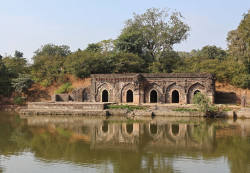 |
# Rewa Kund A reservoir constructed by Baz Bahadur for the purpose of supplying water to Rani Roopmati’s Pavilion. The reservoir is situated below the pavilion and hence is considered an architectural marvel. |
Mandu Sightseeing
Home / Mandu Sightseeing
Developed By
|Feelindia











